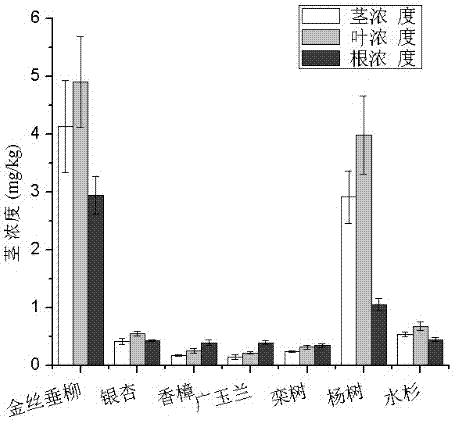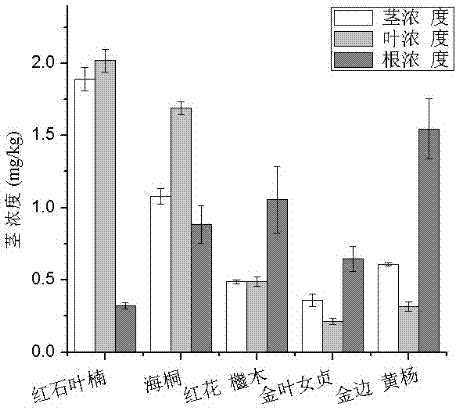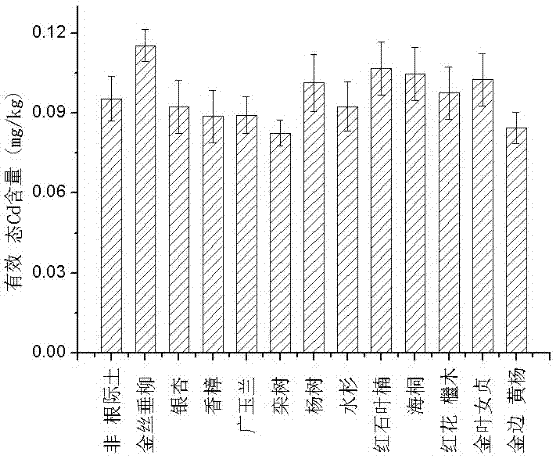Application of koelreuteria paniculata/euonymus japonicus allocation combination for fixing heavy metal in soil
A technology of heavy metals and eucalyptus, applied in the field of phytoremediation of contaminated soil, to achieve the effect of passivating heavy metals, protecting surface soil, and reducing environmental risks
- Summary
- Abstract
- Description
- Claims
- Application Information
AI Technical Summary
Problems solved by technology
Method used
Image
Examples
Embodiment 1
[0025] The construction site of this example is a park in Changshu City, Jiangsu Province. The soil is dredging sludge at the bottom of the lake. The heavy metal pollution in the soil is serious. The Cd concentration is 0.93mg / kg. The heavy metal content seriously exceeds the standard, which seriously threatens the local ecological environment and human health.
[0026] Construction method:
[0027] (1) Plow the contaminated soil, mix it with a rotary tiller, and rake it. Make good drainage measures around.
[0028] (2) In March, common and fixed greening trees were selected: weeping willow, ginkgo, camphor, magnolia, eucalyptus, metasequoia, and poplar, and planted in heavy metal-polluted soil at 2m×3m intervals, to Strong resistance to screening heavy metals; among them, weeping willows are planted in stems, and ginkgo, camphor, magnolia, eucalyptus, metasequoia, and poplar are planted with roots.
[0029] (3) Water the seedlings after they are planted, and conduct regular...
Embodiment 2
[0033] The soil used in the present embodiment is the same as that of embodiment 1, and land arrangement and sub-bed processing are the same as embodiment 1, and the concrete construction method is as follows:
[0034] (1) In December and January in winter, use a tiller to plow the soil 30cm deep, and dry the field for more than one month. In February, use a rotary tiller to mix and harrow the soil.
[0035] (2) Treat the beds according to the field trend, each bed is 3m wide, and open a ditch between the beds as a drainage ditch. According to the actual situation, you can also spray herbicides before planting.
[0036] (3) Select annual shrub seedlings: Photinia fragrans, Pittosporum, Roropetalum safflower, Buxus Phnom Penh, and Ligustrum aureus seedlings are planted in polluted soil with roots, and the planting density is 20-25 / m 2 .
[0037] (4) Water the seedlings after planting, and manage them in the normal field.
Embodiment 3
[0041] The soil used in the present embodiment is the same as that of Example 1, and land preparation and sub-bed processing are the same as Example 1. The preferred arbor plant eucalyptus and shrub plant Euonymus chrysanthemum in Examples 1 and 2 were combined in an effective scientific configuration to study the plant fixation and restoration effect of the greening plant configuration combination.
[0042] The construction method is as follows:
[0043] (1) In March, select eucalyptus trees with a diameter of 2-3cm, remove the top twigs, and plant them in polluted soil with a spacing of 2m×3m; plant the annual Phnom Penh Boxwood seedlings directly around Phnom Penh Boxwood at a planting density of 20-25 / m 2 .
[0044] (2) After the greening plants are planted, water them on the same day, keep the soil moist within one week after planting, and then manage them normally in the field.
[0045](3) The green plants were sampled and analyzed in the fall of the year after plant...
PUM
 Login to View More
Login to View More Abstract
Description
Claims
Application Information
 Login to View More
Login to View More - R&D
- Intellectual Property
- Life Sciences
- Materials
- Tech Scout
- Unparalleled Data Quality
- Higher Quality Content
- 60% Fewer Hallucinations
Browse by: Latest US Patents, China's latest patents, Technical Efficacy Thesaurus, Application Domain, Technology Topic, Popular Technical Reports.
© 2025 PatSnap. All rights reserved.Legal|Privacy policy|Modern Slavery Act Transparency Statement|Sitemap|About US| Contact US: help@patsnap.com



